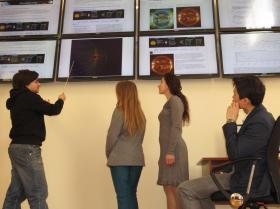Soon space data visualization hall will be opened in the Space Monitoring Dara Center of SINP MSU, where current space weather will be displayed at plasma-panels.
"Real data observations and its online analysis are very important. Analysis of data referred to different space objects and received from different sources provides synergetic effect, which result in the better understanding of the processes happened in the near-Earth space", - the Head of the Space Monitoring Data Center of SINP MSU Vladimir Kalegaev told us.
The space weather is necessary to be evaluated in order to produce alerts about the variations of radiation conditions in the near-Earth space, which can happen due to variations of solar or geomagnetic activity and can be dangerous for satellites' electronic components.
Vladimir Kalegaev also explained us: "Increasing of high-energy particles can easily result in failures of operation of satellites' electronic systems. High-energy particles pass through the outer cover of the spacecraft and destroy the inner structure of electronic microcircuits. Currently used improved technologies, which lead to the development of compact electronics, at the same time make it more sensitive to the dangerous influence of high-energy particles. During the analysis of possible effects of proton events it is important to know the location of the spacecraft and the structure of the magnetospheric magnetic field, which depends on the level of geomagnetic disturbance."

Photo by Oleg Barinov
In the visualization hall it is planned to display information, automatically received from the Russian satellites "Meteor-M1" and "Elektro-L1" (data on electrons and protons flux) and from the foreign spacecrafts SDO - Solar Dynamics Observatory, NASA (images of the Sun within different wavelength ranges), ACE - Advanced Composition Explorer, NASA (data on the solar wind parameters at libration point L1), GOES - Geostationary Operational Environmental Satellite, NOAA (data on the particles flux at the geostationary orbit). Information calculated by operational models of space medium, developed by SINP scientists (magnetospheric magnetic field conditions, forecasts of geomagnetic indices, solar wind, etc.), will be also displayed at the monitors.
Similar visualization halls are currently operated in the world space weather centers of NOAA (Boulder) and NASA (Greenbelt).

